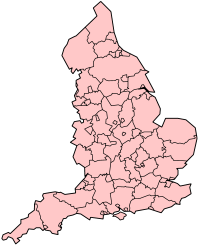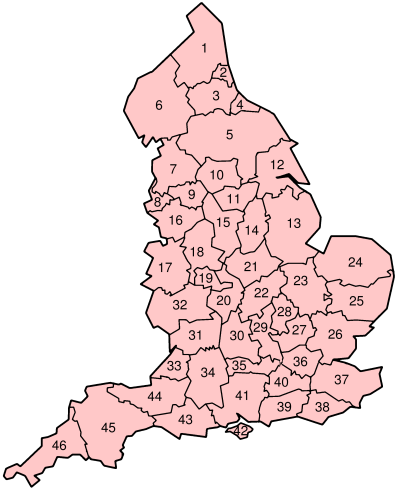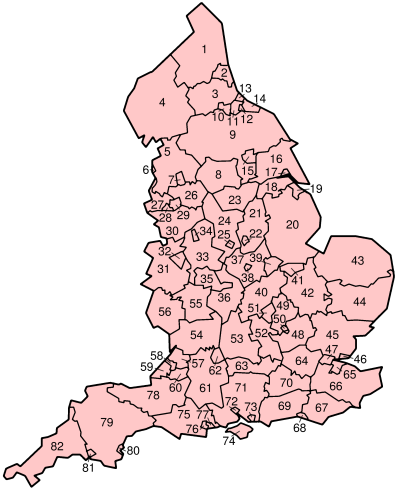Metropolitan and non-metropolitan counties of England
| Metropolitan county Non-metropolitan county |
|
|---|---|
 |
|
| Location | England |
| Found in | Region |
| Created by | Local Government Act 1972 |
| Created | 1974 |
| Number | 83 (as at 1 April 2009) |
| Possible types | multiple district (34) |
| single district (49) | |
| Possible status | non-metropolitan (77) |
| metropolitan (6) | |
| Additional status | with county council (27) |
| with no council (7) | |
| with district council (49) | |
| Subdivisions | Metropolitan district |
| Non-metropolitan district | |
Metropolitan and non-metropolitan counties are one of the four levels of subdivisions of England used for the purposes of local government outside Greater London. As originally constituted, the metropolitan and non-metropolitan counties each consisted of multiple districts, had a county council and were also the counties for the purposes of Lieutenancies. Later changes in legislation during the 1980s and 1990s have allowed counties without county councils and 'unitary authority' counties of a single district. Counties for the purposes of Lieutenancies are now defined separately, based on the metropolitan and non-metropolitan counties. In 2009 there were further structural changes in some areas.
Contents |
Current metropolitan and non-metropolitan counties of England
* unitary authority
† metropolitan county (no county council)
‡ non-metropolitan county with no county council
¹ 'administrative area' and region (not a county).
Metropolitan counties
| England |
.svg.png) This article is part of the series: |
|
|
|
Government
Law and justice
England in the UK
England in the EU
Local government
|
|
Other countries · Atlas |
The metropolitan counties are Greater Manchester, Merseyside, South Yorkshire, Tyne and Wear, West Midlands and West Yorkshire. The counties typically have populations of 1.2 to 2.8 million.[1]
The county councils of these were abolished in 1986 by the Thatcher government for largely political rather than practical reasons, but the counties themselves still exist legally.[2] They are used for some administrative and geographic purposes, and are still ceremonial counties. Most of the powers that the former county councils had were devolved to their metropolitan boroughs, which are now in effect unitary authorities; however, some functions (such as emergency services, civil defence and public transport) are still run jointly on a metropolitan-county-wide basis.[3]
Greater London
The Greater London administrative area and the Greater London Council were created in 1965 by the London Government Act 1963.[4] The Greater London Council was abolished in 1986 at the same time as the metropolitan county councils. Since 2000 Greater London has had an elected Assembly and Mayor, and forms the London region of England.
Non-metropolitan counties
Shire counties
A 'shire county' is a non-metropolitan county that has multiple districts. Its name need not have 'shire' in it. The term shire county is however unofficial.
There are 28 such counties:
Berkshire, Buckinghamshire, Cambridgeshire, Cumbria, Derbyshire, Devon, Dorset, East Sussex, Essex, Gloucestershire, Hampshire, Hertfordshire, Kent, Lancashire, Leicestershire, Lincolnshire, Norfolk, North Yorkshire, Northamptonshire, Nottinghamshire, Oxfordshire, Somerset, Staffordshire, Suffolk, Surrey, Warwickshire, West Sussex, Worcestershire.
All, apart from Berkshire,, have county councils. Sometimes 'shire county' is used to exclude Berkshire, because it has no county council. The counties have populations of 109,000 to 1.4 million.[1] Under local government reforms coming into effect in 2009, the number of such counties was reduced. The non-metropolitan counties of Bedfordshire and Cheshire were split into two separate non-metropolitan counties respectively, while Cornwall, County Durham, Northumberland, Shropshire and Wiltshire became unitary authorities each of a single district.
Unitary authorities
Unitary authorities are areas with only one council. 49 of these are coterminous with a non-metropolitan county:
Bath and North East Somerset, Bedford, Blackburn with Darwen, Blackpool, Bournemouth, Brighton and Hove, Bristol, Central Bedfordshire, Cheshire East, Cheshire West and Chester, Cornwall, Darlington, Derby, Durham, East Riding of Yorkshire, Halton, Hartlepool, Herefordshire, Isle of Wight, Kingston upon Hull, Leicester, Luton, Medway, Middlesbrough, Borough of Milton Keynes, North East Lincolnshire, North Lincolnshire, North Somerset, Northumberland, Nottingham, Peterborough, Plymouth, Poole, Portsmouth, Redcar and Cleveland, Rutland, Shropshire, South Gloucestershire, Southampton, Southend-on-Sea, Stockton-on-Tees, Stoke-on-Trent, Swindon, Telford and Wrekin, Thurrock, Torbay, Warrington, Wiltshire, York
Forty-three of these are defined as counties with a single district council, and no county council. The Isle of Wight, Cornwall, Durham, Northumberland, Shropshire and Wiltshire are technically counties with a county council and no district councils, but the effect is the same.
The districts of Berkshire are unitary authorities, but are not granted county status.
The Isles of Scilly are not part of Cornwall for administrative purposes, but neither do they constitute a county.
History
The current system of metropolitan and non-metropolitan counties came into effect on 1 April 1974 and replaced the administrative counties and county boroughs, which were abolished at that time. Greater London was created in 1965 under separate legislation.
In the 1990s a new type of non-metropolitan county was created: the unitary authority, which combines the functions and powers of county and district. The existing non-metropolitan counties became known as shire counties to distinguish them from the unitary authorities.
Local Government Act 1972
By the late 1960s, it had become obvious that the structure of local government in England and Wales needed reforming. Harold Wilson's Labour government set up the Redcliffe-Maud Commission to produce proposals for wholesale reform.
The report proposed that for most of England the two-tier structure be abolished, and replaced with a system of 58 unitary authorities, which would generally ignore the previous administrative boundaries in favour of changes that made geographic sense - a total redrawing of the map. In the metropolitan areas of Merseyside, South East Lancashire and North East Cheshire, and the Birmingham area, there would be 3 metropolitan areas, with 20 district authorities.
These proposals were opposed by the Conservative Party opposition led by Edward Heath. They won the 1970 general election, and set to work defining their own scheme. This scrapped the concept of unitary authorities (even for existing county boroughs) – the entire area of England and Wales was to be divided into uniform counties and districts. In England the new divisions were to be largely modelled on the existing counties with quite radical reforms put forward, even in some non-metropolitan areas.
Despite reassurances from the government that nobody's loyalties were expected to change as a result of the local government reform, many changes did incur significant local opposition. Most of the radical changes were withdrawn. One aspect the government stood firm on was the mergers of small counties. Campaigns for the continuation of Rutland and Herefordshire were unsuccessful, although due to its special geographic circumstances, the Isle of Wight was permitted to retain a separate county council, as opposed to being reunified with its historic county of Hampshire.
The Local Government Act was passed in 1972, and defined the English counties and metropolitan districts, but not the non-metropolitan districts. These were set by a Boundary Commission that had already begun work.[5]
The metropolitan counties were composed as follows:
- Merseyside - based around Liverpool, south-west Lancashire, along with the Wirral in north-west Cheshire, on the other side of the River Mersey,
- Greater Manchester - the Manchester urban area along with many surrounding towns
- South Yorkshire - based upon the Sheffield-Rotherham area in the West Riding of Yorkshire
- Tyne and Wear - the Tyneside conurbation based on Newcastle-upon-Tyne in Northumberland, along with Sunderland in County Durham
- West Midlands - Birmingham conurbation, including the Black Country and Coventry
- West Yorkshire - Leeds-Bradford area in the West Riding
Other significant changes were:
- Avon formed from northern Somerset, southern Gloucestershire, and Bristol and Bath
- Cleveland formed from southern Durham and northern part of the North Riding, focusing on the Teesside conurbation along with Guisborough and Hartlepool
- Cumbria was formed from Westmorland, Cumberland and part of Lancashire and Yorkshire
- Herefordshire and Worcestershire were merged into Hereford and Worcester
- Humberside formed from eastern Yorkshire and northern Lincolnshire
- Huntingdon and Peterborough was annexed by Cambridgeshire
- Rutland was merged into Leicestershire as a district
- Vale of White Horse, including Berkshire's former county town Abingdon, was ceded to Oxfordshire, as was the area around Wallingford and Didcot now comprising the western half of the South Oxfordshire District
- Bournemouth was moved from Hampshire to Dorset, to join its sister town of Poole
The changes were adopted by the Royal Mail for the purposes of postal addresses wherever they were able, with the notable exceptions of Hereford and Worcester and Greater Manchester. Humberside was divided for this purpose into North Humberside and South Humberside.
Map 1974–1996
| Counties of England from 1974 to 1996 | ||
|
 |
|
Abolition of metropolitan county councils
In 1986 the county councils of the metropolitan counties and the Greater London Council were abolished by Margaret Thatcher's government following disputes with central government, but the counties themselves remained legally in existence.
Local Government Act 1992



The 1990s led to the restoration of county boroughs under a new name, unitary authorities, which radically changed the administrative map of England. The changes were carried out in several waves.
On 1 April 1995, the Isle of Wight became a single unitary authority. It had previously had a two-tier structure with an Isle of Wight County Council, Medina Borough Council and South Wight Borough Council. Also on this day, two small areas were ceded from Surrey and Buckinghamshire to Berkshire, giving it a border with Greater London.
On 1 April 1996, the unpopular counties of Avon, Humberside and Cleveland were abolished and their former area divided into unitary districts. Also at this time, the city of York was expanded and separated from North Yorkshire.
On 1 April 1997, the districts of Bournemouth, Darlington, Derby, Leicester, Luton, Milton Keynes, Poole, Portsmouth, Rutland, Southampton, Stoke-on-Trent and Swindon (based on the former Thamesdown district) became unitary authorities. Also, the districts of Brighton and Hove were merged to form the new unitary authority of Brighton and Hove.
On 1 April 1998, Blackburn with Darwen (based on the former Blackburn district), Blackpool, Halton, Nottingham, Peterborough, Plymouth, Southend-on-Sea, Telford and Wrekin (based on the former Wrekin district), Torbay, Thurrock and Warrington became unitary authorities. Also, the districts of Rochester-upon-Medway and Gillingham were merged to form the new unitary authority of Medway, and the county of Hereford and Worcester was abolished and replaced by the unitary authority of Herefordshire and the shire county of Worcestershire. Berkshire was split into six unitary authorities, but not formally abolished.
2009 structural changes
In April 2009 the following changes were made to the non-metropolitan counties:
| Non-metropolitan county | Action |
|---|---|
| Bedford (borough) | Also became a non-metropolitan county[6] |
| Bedfordshire | Abolished[6] |
| Central Bedfordshire | New non-metropolitan county[6] |
| Cheshire | Abolished[7] |
| Cheshire East | New non-metropolitan county[7] |
| Cheshire West and Chester | New non-metropolitan county[7] |
The effect was that Bedfordshire and Cheshire became ceremonial counties that do not correspond to a non-metropolitan county of the same name.
See also
- Counties of England
- Subdivisions of England
- Ceremonial counties of England
- List of articles about local government in the United Kingdom
References
- ↑ 1.0 1.1 Jones, B. et al., Politics UK, (2004)
- ↑ Elcock, H, Local Government, (1994)
- ↑ Her Majesty's Stationery Office, Aspects of Britain: Local Government, (1996)
- ↑ Bryne, T., Local Government in Britain, (1994)
- ↑ Arnold-Baker, C., Local Government Act 1972, (1973)
- ↑ 6.0 6.1 6.2 Office of Public Sector Information - Bedfordshire (Structural Changes) Order 2008 (Draft)
- ↑ 7.0 7.1 7.2 Office of Public Sector Information - Cheshire (Structural Changes) Order 2008 (Draft)
External links
- European Parliamentary Elections Act 1999 - Schedule 2 - Electoral Regions in England listing many counties extant at that date
|
|||||||||||||||||
|
||||||||||||||
